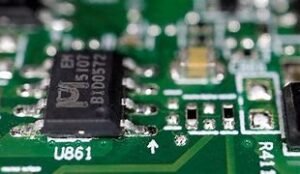Prime Minister Narendra Modi criticized past governments for failing to launch India’s semiconductor mission 30 years ago.
During the interview, PM Narendra Modi stated, “It is unfortunate that for 30 years, people in power were merely running governments, not the nation.”

“The semiconductor mission is something we should have undertaken 30 years ago. When asked about his government’s efforts to establish India as a worldwide semiconductor manufacturing powerhouse, he said, “We are already late.”
The BJP-led NDA government has made a number of initiatives to strengthen India’s position as a global chip manufacturing powerhouse.
These involve the big production-linked incentive plan, Semicon India Programme, and others. It is worth mentioning that the government’s efforts to develop India into a semiconductor manufacturing powerhouse have attracted significant corporations such as US chipmaker Micron Technology and Taiwanese contract electronics manufacturing giant Foxconn.
This comes after on Thursday, the Union Cabinet authorised the development of three semiconductor facilities under the ‘Development of Semiconductors and Display Manufacturing Ecosystems in India’ scheme.
Construction of three semiconductor plants
The three semiconductor plants would be constructed in Dholera, Gujarat, Morigaon, Assam, and Sanand, Gujarat. Union Minister for Electronics and Information Technology, Ashwini Vaishnaw, stated that all three plants will begin construction totaling Rs. 1,25,600 crores within the next 100 days and emphasised the need of establishing a semiconductor facility in Assam. The chips in Dholera and Morigaon facilities are going to be built by the Tata Electronics Pvt. Ltd. and Tata Semi-Conductor Assembly and Test Pvt. Ltd. The Powerchip Semiconductor Manufacturing Corporation (PSMC) of Taiwan is going to be the technology partner for the fab unit in the Dholera unit while the technology partner in the Morigaon has been kept confidential at their request.
The Cabinet’s announcement further emphasised the strategic relevance of these three entities.

“Within a relatively short time, the India Semiconductor Mission has accomplished four major triumphs. These units will help to create India’s semiconductor ecosystem. India already has extensive expertise in chip design. With these machines, our country will enhance its chip production capabilities. With today’s announcement, advanced packaging technologies will be developed indigenously in India”, asserted the Minister.
The Programme for Development of Semiconductors and Display Manufacturing Ecosystem in India was approved on December 21, 2021, with a total investment of Rs 76,000 crore.
During the interview, PM Modi discussed numerous aspects of India’s economy, including job creation, infrastructure development, and initiatives in sophisticated technology such as artificial intelligence (AI).
The Prime Minister stated that job creation has been the government’s primary priority, and all efforts have been directed towards this goal. “It is well acknowledged that investments in infrastructure have a significant multiplier effect on growth and employment. As a result, we have consistently expanded our capital investment outlays. The budget for 2023-24 has been enhanced significantly to Rs 10 lakh crore, up from Rs 1.9 lakh crore in 2013-14,” PM Modi stated.
In the field of AI
The Prime Minister desires India to lead in the area of artificial intelligence. “We will be working on our own computing power in large indigenous language models, keeping in mind the diversity of Indian languages and our needs,” he went on to say.
“Technological leadership necessitates a mentality shift. Today, from schools to boardrooms, we ensure that the focus is on innovation and easy access to finance, as well as progressive and stable legislation. Remember that today’s innovations will shape tomorrow’s industries. “And it is industry that drives investment and income growth,” he said.
India’s $5 trillion goal

When asked what steps are being taken to achieve India’s $5 trillion economic ambition, PM Modi responded, “Our track record speaks for itself. When I became Gujarat’s chief minister in 2001, the state’s economy was worth around $26 billion (Rs 2.17 lakh crore). When I left Gujarat to become Prime Minister, the state’s GDP was about $133.5 billion (Rs 11.1 lakh crore).
“As a consequence of different policies and reforms, Gujarat’s economy is now worth around $260 billion (Rs 21.6 lakh crore). Similarly, when I became Prime Minister in 2014, India’s GDP was $2 trillion (Rs 167 lakh crore), and by the end of 2023-24, it would be more than $3.75 trillion (Rs 312 lakh crore). The 23-year track record demonstrates that this is a feasible goal,” he continued.










